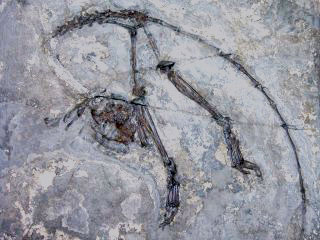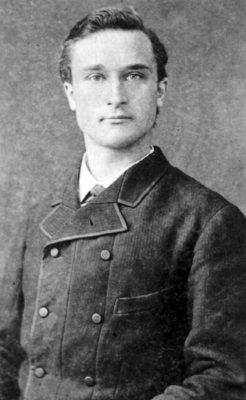 Charles Darwin started the debate over where humans originated. In the 19th century, most evolution scientists believed humans originated in Asia – the out-of-Asia model. In the 6th edition of the Origin of Species (1872), while Darwin mentions “humans” ten times, he never discusses the origin of humans.
Charles Darwin started the debate over where humans originated. In the 19th century, most evolution scientists believed humans originated in Asia – the out-of-Asia model. In the 6th edition of the Origin of Species (1872), while Darwin mentions “humans” ten times, he never discusses the origin of humans.
For the 1st edition of the Descent of Man (1871), Darwin studied African apes. In the section entitled “On the Birthplace and Antiquity of Man,” Darwin argued, “it is somewhat more probable that our early progenitors lived on the African continent than elsewhere.” Darwin started evolution’s out-of-Africa vs. out-of-Asia dilemma.
While Darwin’s Bulldog, Thomas Huxley (pictured right), supported the out-of-Africa theory, few others did. Most evolution scientists, at that time, believed humans originated in Asia. The out-of-Asia model, supported by many evolutionists, including Ernst Haeckel, Eugene Dubois, Henry Fairfield Osborn, and Roy Chapman Andrews, was the accepted theory.
 In 1891, searching Indonesia, Eugène Dubois discovered the remains of what he described as “a species in between humans and apes” – an early transitional link. Naming the link Pithecanthropus erectus (“ape-human that stands upright”) or Java Man, the fossil record remains are now known as Homo erectus – “human that stands upright.”
In 1891, searching Indonesia, Eugène Dubois discovered the remains of what he described as “a species in between humans and apes” – an early transitional link. Naming the link Pithecanthropus erectus (“ape-human that stands upright”) or Java Man, the fossil record remains are now known as Homo erectus – “human that stands upright.”
Interestingly enough, a decade earlier, in 1881, while on vacation near the Dutch village of Rijckholt, and inspired by the fresh discovery of new Neanderthal fossils at the Belgian town of Spy, Dubois unearthed prehistoric human skulls in a freshly discovered flint mine.
Not until Raymond Dart’s highly controversial 1924 discovery in South Africa of the first African (hominid), Australopithecus africanus, was the attention given to the out-of-Africa model.
New Out-of-Asia Evidence
 In the prestigious journal Nature, an international team of scientists published their paper entitled “The oldest known primate skeleton and early haplorhine evolution.” A research team led by Xijun Ni (pictured left) of the Chinese Academy of Sciences in Beijing, China, studied the primate fossil found in Asia known as Haplorhini for ten years. The classification of this ‘dry-nosed’ primate is in the family known as tarsiers.
In the prestigious journal Nature, an international team of scientists published their paper entitled “The oldest known primate skeleton and early haplorhine evolution.” A research team led by Xijun Ni (pictured left) of the Chinese Academy of Sciences in Beijing, China, studied the primate fossil found in Asia known as Haplorhini for ten years. The classification of this ‘dry-nosed’ primate is in the family known as tarsiers.
Erik Seiffert, associate professor at Stony Brook University, who was not involved in the study, said in an interview with Elizabeth Landau writing for CNN –
“In my opinion, it is one of the most important discoveries in the history of paleoprimatology.”
The evidence Ni presented is a single nearly complete skeletal remains unearthed in an ancient lake in what is now known as the Hubei Province near the modern Yangtze River in 2002. The fossil embedded within the slate was named Archicebus achilles (pictured above left). There are no other known Archicebus fossils.
The name given to the fossil recognizes the bones as the oldest known primate skeleton along with its different heels. Archicebus is from arche (ἀρχή), the Ancient Greek word for “beginning,” and cebus, the Latin version of the Ancient Greek kêbos (κῆβος), which refers to a long-tailed monkey. The species name, achilles, is a reference to Achilles, the Greek hero of the Trojan War from Greek mythology.
While the heel is the weak spot of the Greek hero, in the Archicebus achilles, the team inverted the analogy so that the heel represents the strong spot as a missing human link. Whatever. At an estimated 7 centimeters (2.8 inches) long and weighing in at an estimated 20 to 30 grams, the fossil is not even one 10th of a pound.
Under the “Microscope”
An analysis of recovered slate fragments performed at the European Synchrotron Radiation Facility (ESRF) in France, detailed the skeletal remains of nearly 1,200 morphological aspects of the fossil still hidden inside  the rock and compared them to those of 156 other extant and extinct mammals.
the rock and compared them to those of 156 other extant and extinct mammals.
The evidence, however, raised new questions. Rather than finding early human evolutionary elements, Archicebus achilles seemed like an “odd hybrid.” Christopher Beard (pictured right), an investigator at the Carnegie Museum of Natural History, Pittsburgh, notes –
“Archicebus differs radically from any other primate, living or fossil, known to science. It looks like an odd hybrid with the feet of a small monkey, the arms, legs, and teeth of a very primitive primate, and a primitive skull bearing surprisingly small eyes. It will force us to rewrite how the anthropoid lineage evolved.”
Transitional links should represent Darwin’s, “slight-successive changes,” not “odd hybrids.” Dan Gebo, an anthropologist from the Northern Illinois University, however, interprets the findings as supporting the out-of-Asia model, noting –
“We see typical robust grasping big toes, long toes, and nailed digits of primitive arboreal primates, but we also have rather monkey-looking heel bones and monkey-like long metatarsals.”
“Tree shrews and flying lemurs — mammalian lineages that are closely related to primates — are both Asian lineages,” Gebo continues –
“Thus, if the two lineages that are closely related to primates are Asian, it is likely that ancestral primates originated there as well. Any other geographical possibility requires a more complicated story.”
 For Ni, there is no doubt about the out-of-Asia model. In an interview with The Telegraph reporter Roger Highfield, Ni notes –
For Ni, there is no doubt about the out-of-Asia model. In an interview with The Telegraph reporter Roger Highfield, Ni notes –
“We can actually deduce, based on our discoveries and others’ that the most primitive primate originated in Asia. The first anthropoid probably is also from Asia.”
“The finding adds weight to the evidence that primates originated in Asia — not Africa,” explains The New York Times science writer John Wilford (pictured left).
Christopher Beard of the Carnegie Museum of Natural History, however, seemed to be somewhat conflicted. in an interview with The Guardian science correspondent Alok Jha noted –
“The evidence that early primate evolution was restricted to Asia is becoming more compelling by the day,”
Out-of-Africa vs. Out-of-Asia Dilemma
Beard, playing the devil’s advocate, noticed the “both sides” of the coin problem –
“We’ve heard of the ‘out of Africa’ theory of human evolution, but that’s recent history. So there may now be the ‘into Africa’ problem.”
If the evidence points to the out-of-Asia model, then the errors in the out-of-Africa model must be validated. Supporters of the out-of-Africa model are formidable, including Richard Dawkins.
Dawkins aligns with the ‘out of Africa’ avant-garde. In The Greatest Show on Earth, demeans Eugene Dubois search efforts in Southeast Asia in 1891 noting that he
“chose the wrong part of the world for his single-minded quest for the ‘missing link.'”
Henry Gee, a science writer for the journal Nature in the article, takes a level-headed approach. In his report the “Return to the planet of the apes,” Gee notes
“Fossil evidence of human evolutionary history is fragmentary and open to various interpretations.”
Science correspondent Ann Gibbons in the journal Science laments how the divergent “story of human evolution has lately become as complicated as a Tolstoy novel” – intensifying Darwin’s Dilemma.
Genesis
 Finding our origins is critical to understanding who we are. In using the most advanced scientific technologies in the history of humanity, however, evolution scientists remain divided over our origins. While the out-of-Africa vs. out-of-Asia dilemma is unresolved and continues to have the evolution industry locked into warring camps, the scientific evidence continues to be compatible with the Genesis account.
Finding our origins is critical to understanding who we are. In using the most advanced scientific technologies in the history of humanity, however, evolution scientists remain divided over our origins. While the out-of-Africa vs. out-of-Asia dilemma is unresolved and continues to have the evolution industry locked into warring camps, the scientific evidence continues to be compatible with the Genesis account.
Lord Rayleigh, an English physicist, discovered the many complex physical properties of light and sound. Rayleigh’s family’s name is John William Strutt, 3rd Baron Rayleigh. During the Scientific Revolution Rayleigh noted –
“I have never thought the materialist view possible, and I look to a power beyond what we see.”
Refer to the Glossary for the definition of terms and to Understanding Evolution to gain insights into understanding evolution.
2020 Updates
With more fossil findings and technological advances over the past five years, the popularity of the out-of-Asia model continued to shaft in favor of the out-of-Africa model. The statements from WIKIPEDIA, Evolution 101, Smithsonian Human Evolution project, and the Harvard University, Department of Human Evolution lend support to the out-of-Africa model.
- WIKIPEDIA challenges Ni’s classification of Ni’s fossil classification. Ni claimed “This fossil is the most basal known member of the Tarsiiformes clade,” that is a problem. According to WIKIPEDIA, there is no scientific consensus on the evolutionary status of Tarsiiformes –
“Even the placement of Tarsiiformes within suborder Haplorhini (with the monkeys and apes”) is still debated.
- WIKIPEDIA supports the out-of-Africa model in these articles.
Early expansions of hominins out of Africa – “Several expansions of populations of archaic humans (genus Homo) out of Africa and throughout Eurasia took place in the course of the Lower Paleolithic.”
Recent African origin of modern humans – “Since the beginning of the 21st century, the picture of “recent single-origin” migrations has become significantly more complex, not only due to the discovery of modern-archaic admixture but also due to the increasing evidence that the “recent out-of-Africa” migration took place in a number of waves spread over a long time period.”
Out of Asia theory – “The Out of Asia theory was a scientific theory that contended that modern humans first arose in Asia. Most anthropologists until the mid 20th century preferred Asia, over Africa, as the continent where the first hominids evolved.[1] The recent African origin of modern humans (“Out of Africa”) theory is currently supported by more data.”
“In Africa, our ancestral lineage and the chimpanzee lineage split… Early Homo sapiens lived in Africa.”
“Humans first evolved in Africa, and much of human evolution occurred on that continent. The fossils of early humans who lived between 6 and 2 million years ago come entirely from Africa. Early humans first migrated out of Africa into Asia.”
“Although an African origin of the modern human species is generally accepted, the evolutionary processes involved in the speciation, geographical spread, and eventual extinction of archaic humans outside of Africa are much debated.” 2008
Oldest human fossil found outside of Africa throws popular theory into doubt – “The closest ancestors of modern-day humans (Homo sapiens) and other subspecies of the genus Homo are thought to have originated in Eastern Africa … until recently, the earliest Homo sapiens fossil found outside of Africa was only about 120,000 years old. A recent discovery of a partially intact Homo sapiens jaw bone in Israel, however, has been dated between 177,000 and 194,000 years old.”

